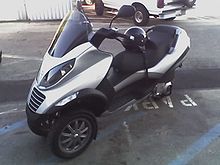Tilting three-wheeler
This article needs additional citations for verification. (July 2008) |




A tilting three-wheeler is a three-wheeled vehicle whose body and or wheels tilt in the direction of the turn. It is the most common leaning multi-wheeler type. Such vehicles can corner safely and comfortably despite having a narrow track.[1] Therefore they are, unlike single-track vehicles such as two-wheeled bicycles and motorcycles, suitable for a year-round utilization time.
Wheel configurations
Several configurations are practical. Two front wheels and one rear, where all three wheels tilt are referred to as 2F3T (i.e. two front three tilt). Other variations include 1F1T, where only the front wheel tilts, an example being the Vandenbrink Carver, made in the Netherlands.
Active or passive tilt control
With bicycles and motor bikes without enclosure, passive tilt control is possible. The rider is responsible for allowing the balance to occur by maintaining a resilient input onto the control. To alter the balance position the rider must actively countersteer the control.
Topology
Propulsion may be on the tilted wheels also with so called tadpoles but requires special controllers when having propulsion on two tilted wheels.[2]
Use of 'extra' wheel
There is no general agreement on how much, or even what use to make of the third wheel on a tilter. Sometimes it does little more than a kickstand with a caster, employed at low speed. These are called free-leaners and they must be balanced through countersteering before turning, just as on a motorcycle or other single-track vehicle. For comfort, the free-leaners are the best for cyclists, as the legs don't get thrown to the side when you hit a bump on one side, and no muscles are used for side support of the torso.
Other tilters use the third wheel to resist wind loads and force a faster lean to set up for a fast corner or emergency lane change. Opinion is divided on how best to control this benefit. Some sort of pendulum and servo is the "obvious" solution, but this system is generally accepted to be unsuitable due to the fact that the observation by the pendulum occurs after the event of steering onto the curved path and so too late to allow proper vehicle dynamics. Various electric and hydraulic systems have been employed to modify TTW behaviour, with notable success on the Carver. Another system has the driver controlling the tilt only, and the chassis steering automatically, so the third wheel is well used, and it may be easier to learn for drivers.
Due to the tilting, there is not necessarily any load transfer between the wheels in cornering, so the rule about tadpoles (2F or "reverse trike") understeering and Deltas (1F or standard trike) oversteering does not necessarily apply. Thus deltas are less dangerous, providing that the tilting is done very accurately during hard braking. Tadpoles can still get through more kinds of trouble with grace.
Some tilting three-wheelers use two buttons on the steering wheel connected to an electric motor to allow the driver to adjust the angle of leaning, while some more modern designs use computer-controlled tilting.
References
- ^ They are "designed to respond to the demands of the more demanding clients concerning safety and comfort". 2012. Retrieved 22 June 2014.
- ^ see enPorter Website
Bibliography
- Poelgeest, A., Edge, K. A. and Darling, J., 2007. Development of a Steer Tilt Controller for a Three Wheeled Tilting Vehicle. In: ASME International Mechanical Engineering Congress and Exposition, 2007-11-01, Seattle, Washington.
- Tilting Three Wheelers - Patents
- The Design, Implementation and Analysis of Motorized Tilting Three-Wheelers. Thesis, Choa-Chin Weng. 18 July 2005. Chinese. English abstract.
- Dynamic Stability of Three-Wheeled Vehicles in Automotive-Type Applications. Robert Q. Riley.
- Carver One
